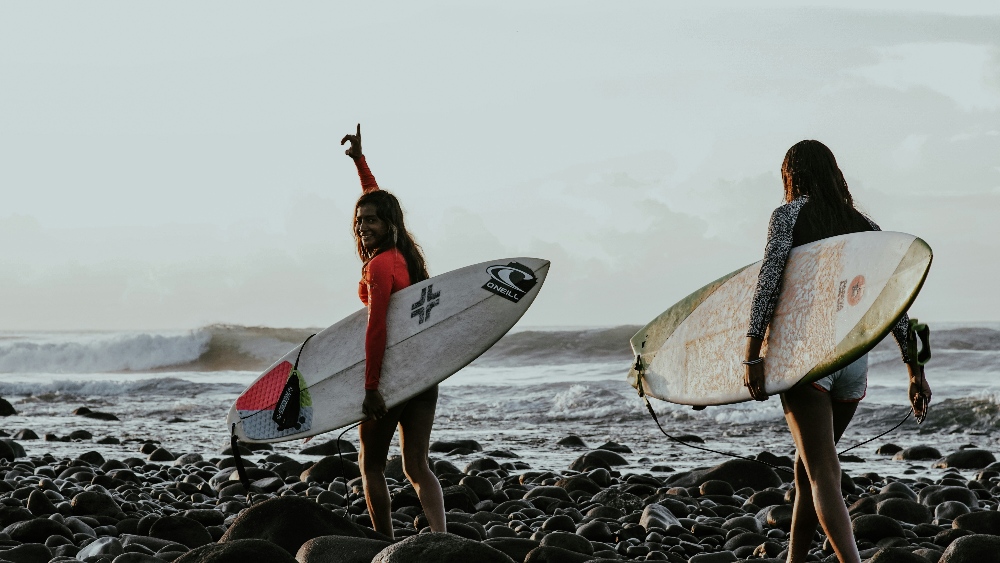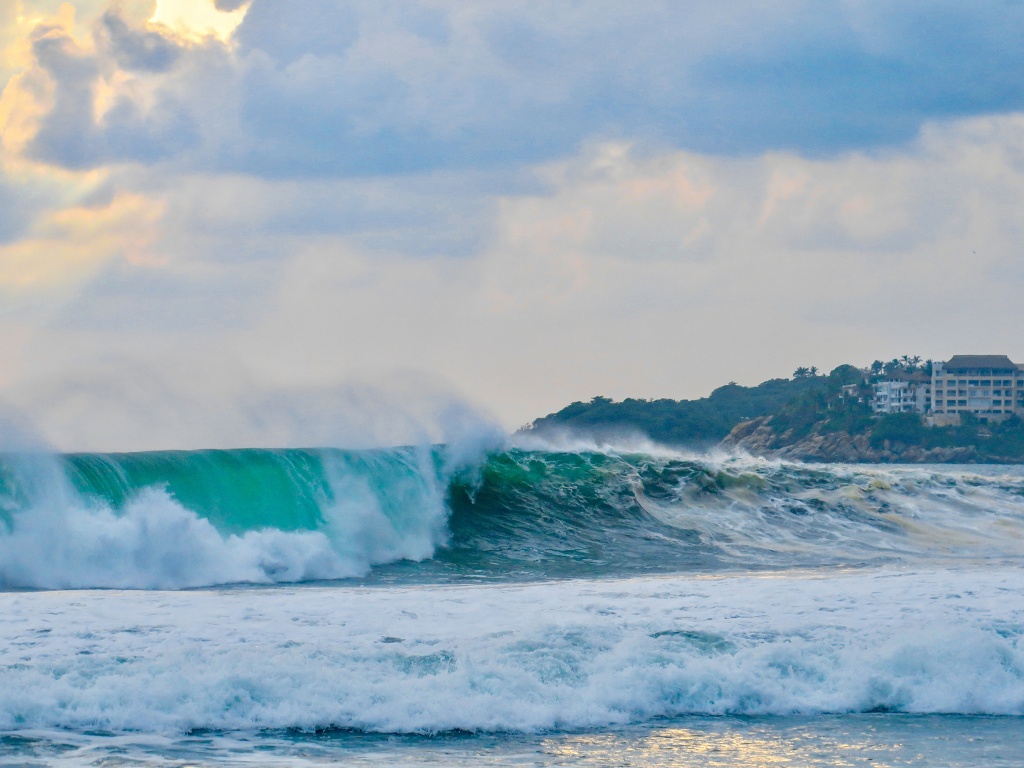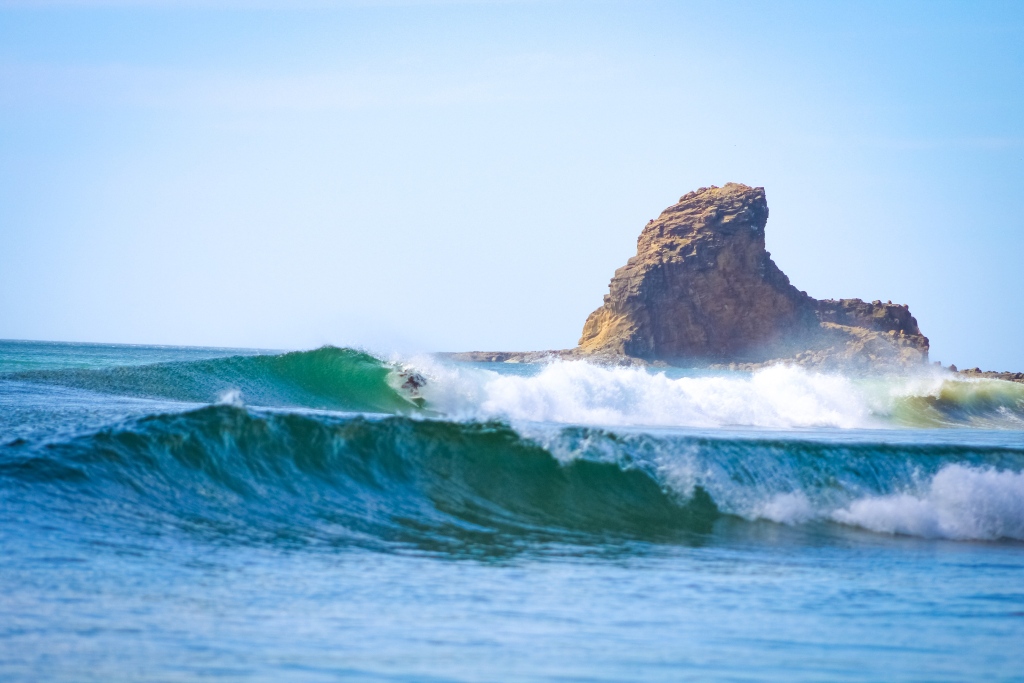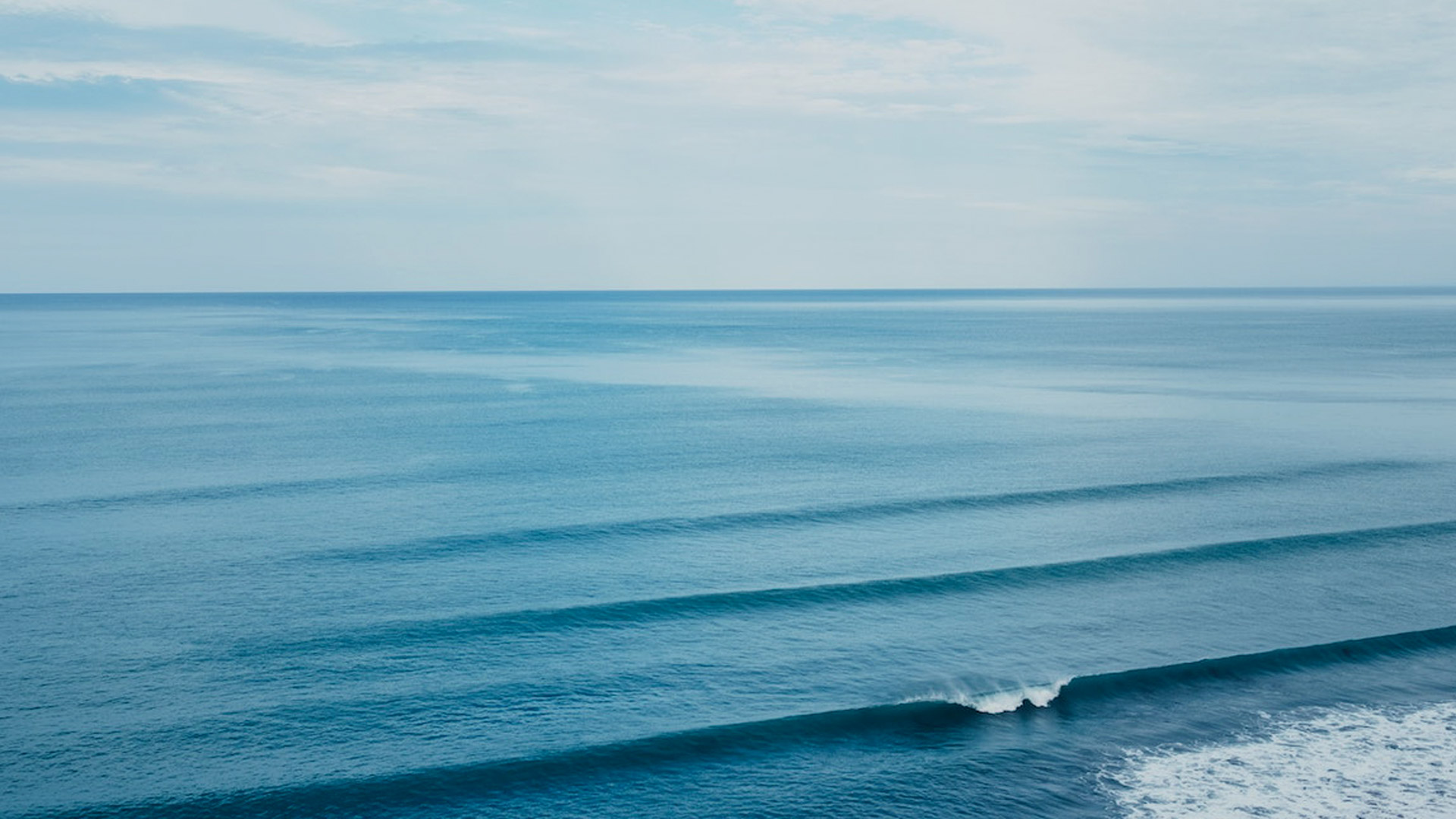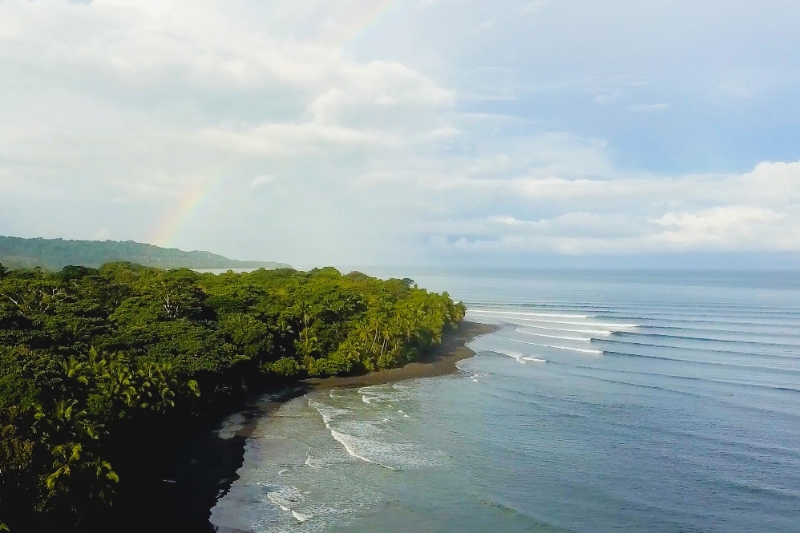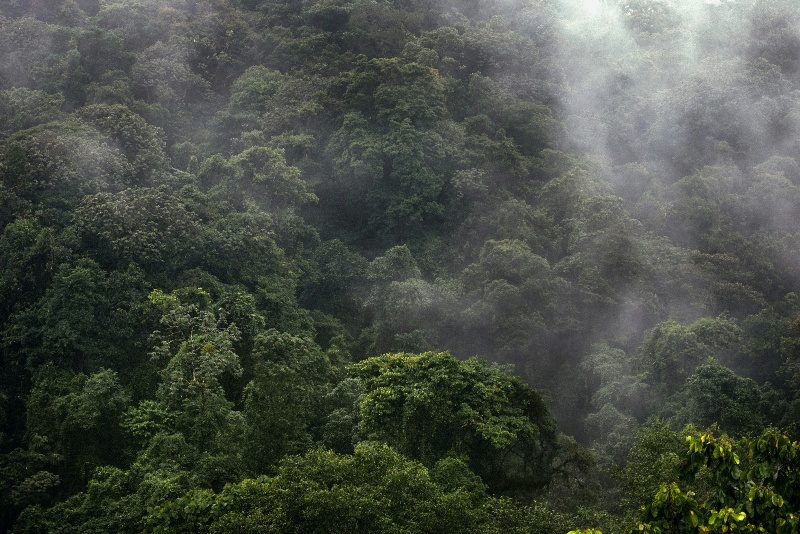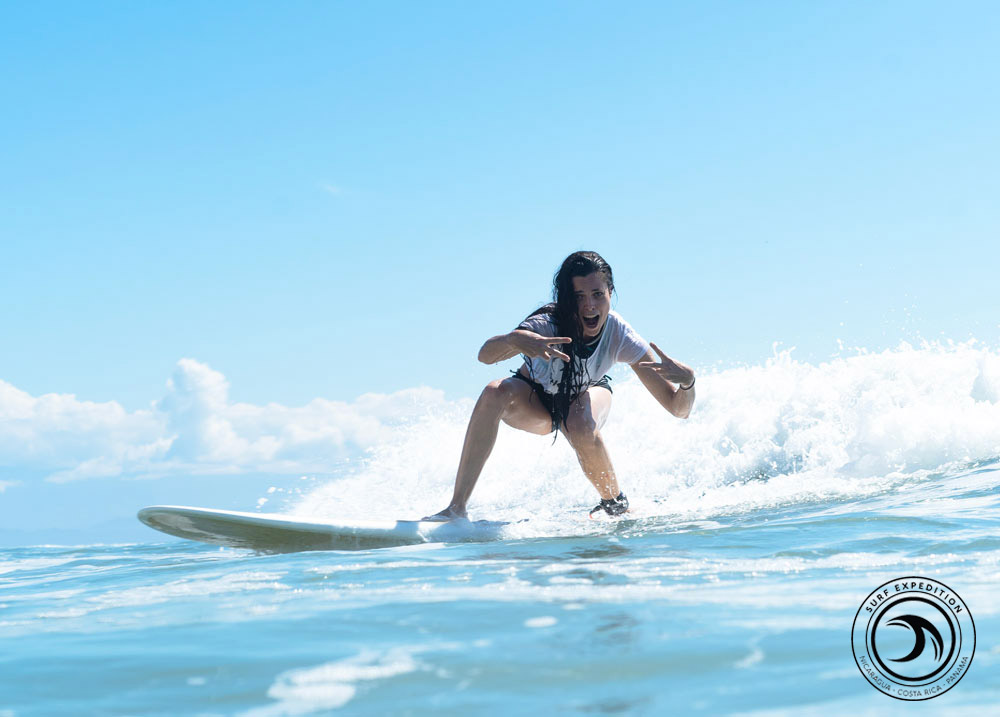
20 Nov When is the Best Time for Surfing in Central America
Are you eager to ride the waves and experience the thrill of surfing in Central America? Here’s a secret, the best time to surf is whenever you can set aside the time for it. Whenever you get that feeling that the ocean is calling for you, you’ll know that it’s the right time. However, if you’re trying to dive into the specific surf seasons, we’ve got you covered in this guide to the best time for surfing in Central America.
When is the best time for surfing in Central America?
Simply put, there is never a bad time for surfing in Central America. If you’re looking for a quick answer though, it depends on your skill level and where you are in Central America! The “dry season”, typically December through mid-April, offers smaller, yet consistent surf and is most popular with beginner and intermediate surfers. This is also the main surf season for the Caribbean.
The “green season” typically runs from May-November, and offers bigger and more consistent surf (except in the Caribbean), which is popular with intermediate and advanced surfers.
With that in mind, there really isn’t a bad time to surf in Central America. Especially when you stay with us at our beachfront surf and yoga camp in Costa Rica, where we have beginner friendly surf breaks all year long!
Here’s what you will find in this travel guide to surfing in Central America:
- Most popular surf beaches for beginners and intermediate surfers
- Overview: Central America Surfing Seasons for Pacific and Caribbean Coasts
- The Pacific Coast “dry season”
- What months can you surf in Costa Rica?
- Surfing Central America coastlines
- The “green season”
- What is the longest wave in Central America?
- The true “rainy season”
- Surfing in Central America: An Ever-Changing Adventure
While the waves wait for you to ride them, one must first understand the seasonal weather patterns along Central America’s Pacific and Caribbean coastlines. In order to enhance your surfing experience, never underestimate weather conditions along the coast.
Surfing in Central America give you the best surf destinations in this vibrant region: From Mexico’s southern tip (Oaxaca) to El Salvador, Nicaragua, Costa Rica, Panama’s Pacific and Caribbean coasts (Bocas del Toro).
Central America is a surfer’s paradise, but when is the best time to visit? This guide will provide you with tips into Central America’s surf seasons and spots. Keep in mind your surfing level and the experiences you seek.
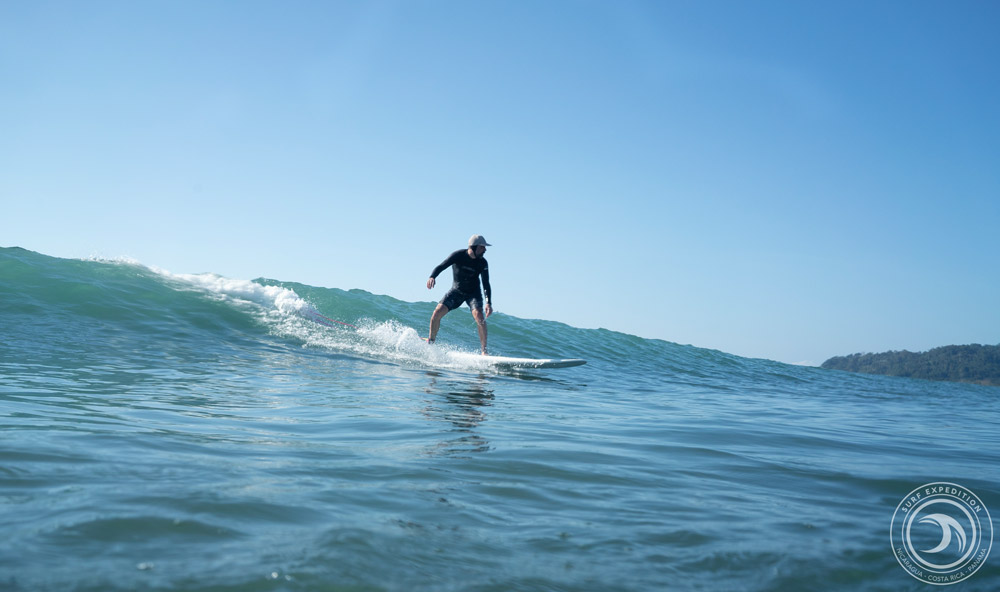
Our guest Ulrich, March 2019 in Costa Rica
Central America Surfing Seasons for Pacific and Caribbean Coasts
- Central America surf season on the Pacific Coast is best for beginner to intermediate surfers with smaller waves from December to Mid-April. The beach breaks will get the best surfing conditions during those months. From mid-April to November the pacific ocean receives more consistent waves which is ideal for experienced surfers.
- Central America surf season on the Caribbean coast is from December to March (Bocas del Toro, Isla Grande in Panama; Puerto Viejo) and this region also receives a few swells in July. Keep in mind that the beaches of the Caribbean coast have more spots geared towards more advanced surfers with a higher skill level.
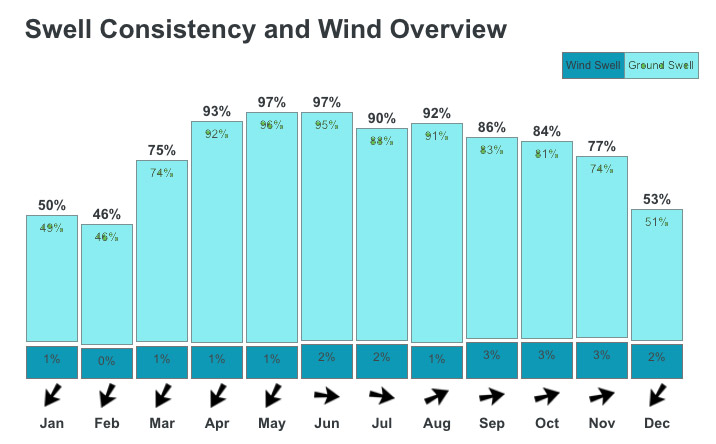
(Pacific Coast | Graph from Magicseaweed.com)
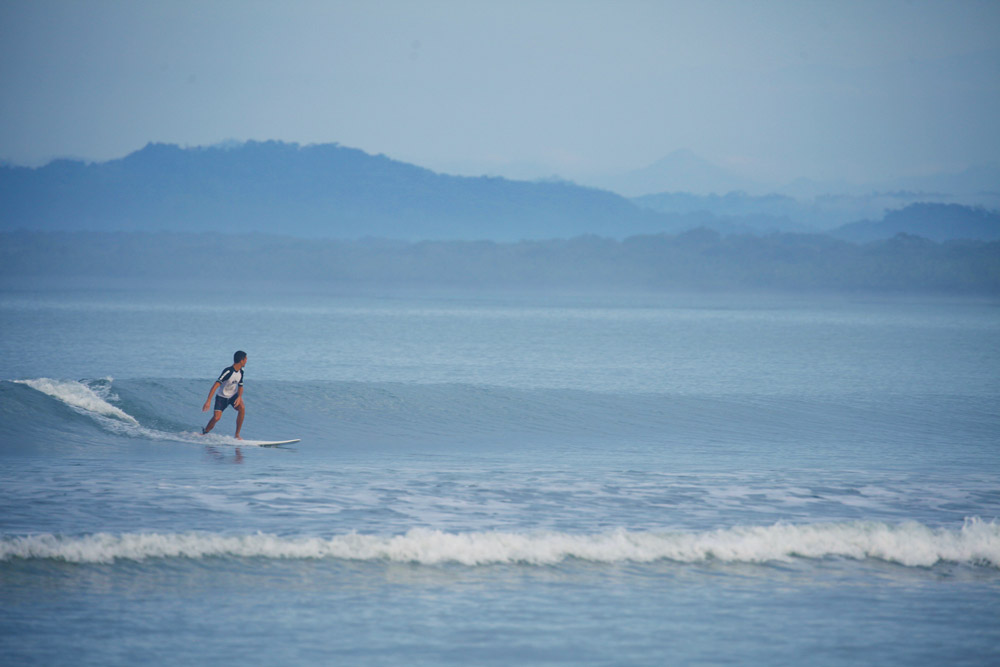
Our guest Alexis, January 29, 2020. We can see waves are knee to shoulder-high at our typical beginner spot in Costa Rica
The Pacific Coast “dry season” (sunshine & smaller fun waves)
The Pacific Coast of Central America experiences two seasons: a “wet season” and a “dry season”.
Considered to have the best surfing for beginner surfers to learn, practice and progress.
The water can be quite cold between January and March, so bring a wetsuit top of 1 or 2mm if you are planning to surf in southern Nicaragua, from the Nicaragua border up to Pochomil: (playa Maderas, playa Remanso, playa Gigante, playa Colorado) and northern Costa Rica (between Witches Rock, Tamarindo, Playa Grande, Nosara, Playa Guiones, Samara, Santa Teresa, Malpais Jaco, Playa Hermosa).
At least you won’t need a 3-4mm wetsuit to surf, like on the US East Coast – much easier to paddle!
Surf tips: If it’s your first time surfing in Central America, booking a week outside a touristic surf town, for example at one of many surf camps located a outside of the populars surfing destinations might help you score less crowded waves and therefor improve faster.
Other popular surf breaks around surf towns such as Sunzal (El Tunco), Punta Roca (La Libertad) in El Salvador, Puerto Escondido and La Punta in Oaxaca, Mexico, Playa Venao (Panama) and Santa Catalina (Panama) have warm water year round and some great surfing.
Planning your Central America surfing trip
Choose your surfing destination based on your skill level and trip objectives.
It’s a good idea to pick your surfing destination according to your skill level and your trip’s objectives (party vs surfing early in the morning before the crowds show up).
You don’t want to be partying all night when the swell is supposed to hit the next morning, check the surf forecast and plan which days you’ll surf and which days you’ll “rest”.
Also be sure not to forget any important surf trip gear essentials before you hit the surf in Central America!
Most popular surf beaches in Central America for beginners and intermediate surfers
- San Juan del sur – Nicaragua
- El Tunco – El Salvador
- Tamarindo – CR
- Jaco – CR
If you’re a beginner surfer headed to Costa Rica, check out our list of tips for beginner surfers in Costa Rica!
Best spots in Central America surfing for the advanced
- Puerto Escondido – Mexico
- Punta Roca – El Salvador
- Playa Colorado – Nicaragua
- Witches Rock – Costa Rica
- Playa Hermosa – Costa Rica
- Santa Catalina – Panama
Best nightlife in popular Central America surf towns
- Playa Venao – Panama
- Bocas del Toro – Panama
- Tamarindo – CR
- Santa Teresa – CR
- El Tunco – El Salvador
Surf in San Juan del Sur
San Juan del Sur is very famous as a touristic surf destination in Nicaragua. It’s good to know that there is no surfing directly in this surf town. Normally, you will have to find transportation to the nearby surf spots around 20 minutes drive each way. Playa Remanso and Playa Hermosa are better for total beginners. Playa Maderas is better for beginner surfers with experience and intermediate surfers because the waves are usually a bit more powerful.
When surfing in this part of Central America, there’s a few tips you’ll have to remember.
Surf Tips: Wearing a top 1-2mm will also help your ribs and skin if you are just starting surfing or haven’t surfed for a while.
Otherwise, the friction with the board can make your belly have rash and irritation if you’re not used to it.
The good news is that during this period there is a phenomenon of offshore winds which makes the waves glassy!
The wind can be strong sometimes but usually calms down towards the end of March, after which you can leave your wetsuit at home.
Until the end of April, the water is warm (with the exception of North Nicaragua and South Costa Rica) and the weather is nice!
So, if this is your first time surfing and you’re looking for good weather first, opt for a trip between January and April on the Pacific coast. Next, search on google maps for Central America surfing areas without too many surf camps.
Bocas del Toro and Puerto Viejo (Salsa Brava-expert surfers only) are an excellent option for surfing good waves in the winter (December-March) if you want to avoid Hawaii’s heavy crowds.
Where to surf in Central America without a wetsuit
If the idea of wearing neoprene during your vacations gives you the chills, don’t worry because the southern part of Costa Rica, where our surf camp is located, the water temperature is always tropical warm.
You will be able to head to the beach and surf in bikini or board short during your holidays, even if you are coming between December and March, unlike the North (Nosara, Tamarindo) and the south of Nicaragua (San Juan del Sur, playa Colorado and Popoyo).
Surf tips for girls: Bring a pair of leggings to prevent irritation to knees and inner thighs and it will protect the back of your legs from the sun when you’re out surfing between 9am to 3pm.
Oily sunscreen on the back of your knees won’t be your best friend, it will make the rails of your board slippery.
What months can you surf in Costa Rica?
Thinking about planning a surf trip to Costa Rica to come and experience some Pura Vida?
The best months for surfing in various regions are as follows:
Caribbean Coast: December to March, with a short surfing season in July.
North Pacific Coast (Guanacaste): November to March
Surf is reasonably consistent year-round, with larger waves during the Costa Rica rainy season (especially in Puntarenas). However, some of the best surf spots are inaccessible in the rainy season due to impassable dirt roads.
The dry season is preferred in the north because offshores are more frequent, roads are better and there are good swells on the Caribbean side and the northern part of the country.
Central Pacific & South Coast (Dominical, Osa Peninsula, Pavones):
December – April for beginner surfers.
May to October for intermediate/experienced surfers.
In the dry season, the central part is still very lush and green while the northern part is dry and dusty.
Environmental hazards
Sharks are present, but no shark attacks have been recorded in the last 10 years.
A few rare crocodile attacks have been recorded in the north part of Costa Rica in the river mouth between Tamarindo and Playa Grande due to crocodiles’ sightseeing tour companies unfortunately feeding them to attract them for their tourists.
Water quality is generally good, but be careful near river mouths after a big rain.
Surfing Central America coastlines
Long point breaks and wide stretches of beach breaks characterize most of the coastline.
The Caribbean side are known for coral reefs and heavy beach breaks. In addition, this region offers the best waves from December to March. Additionally, Isla Colon and Puerto Viejo are renowned for their vibrant nightlife.
The Pacific side, here the mornings are typically offshore, making it the best time to surf due to smaller crowds and cooler temperatures.
The northern part of the country – From the border of Nicaragua to Jaco beach is dryer than the southern part.
In the dry season, the southern part is still very lush and green while the northern part is dry and dusty.
Surfing Central America during the “green season”
The “green season” is the best time to score big swells with sunny days and occasional rain. Thus making the consistent swells ideal for all levels of surfers.
During this season, the swells are regular, and the winds are calmer on the Pacific coast. Water temperatures remain warm year-round, eliminating the need for a wetsuit. Except Bocas del toro where the winds are more irregular.
If your priority is surfing big waves, this is the best time to travel. It is between the last week of April and the first week of May that the Pacific coast usually receives the first large S-SW swells.
So if you are an experienced surfer, keep an eye on the surf forecast via surfline.com and start training! After the first big swell, the conditions become regular for all levels to enjoy.
The biggest waves of Central America
The biggest waves for surfing Central America usually hits Puerto Escondido.
Hence, beginners should be more careful when planning a trip there outside of the small swell window of December-March.
Should you end up in Puerto Escondido at the wrong time, La Punta can be a better option for intermediate surfers, but ofter very crowded. Playa Carrizalillo, a sheltered bay and soft-rolling waves, is the best surfing spot for beginners and intermediates during the bigger swell season of April-November.
Central America’s “green season” is the perfect time for consistent swells and ideal conditions for all levels of surfers.
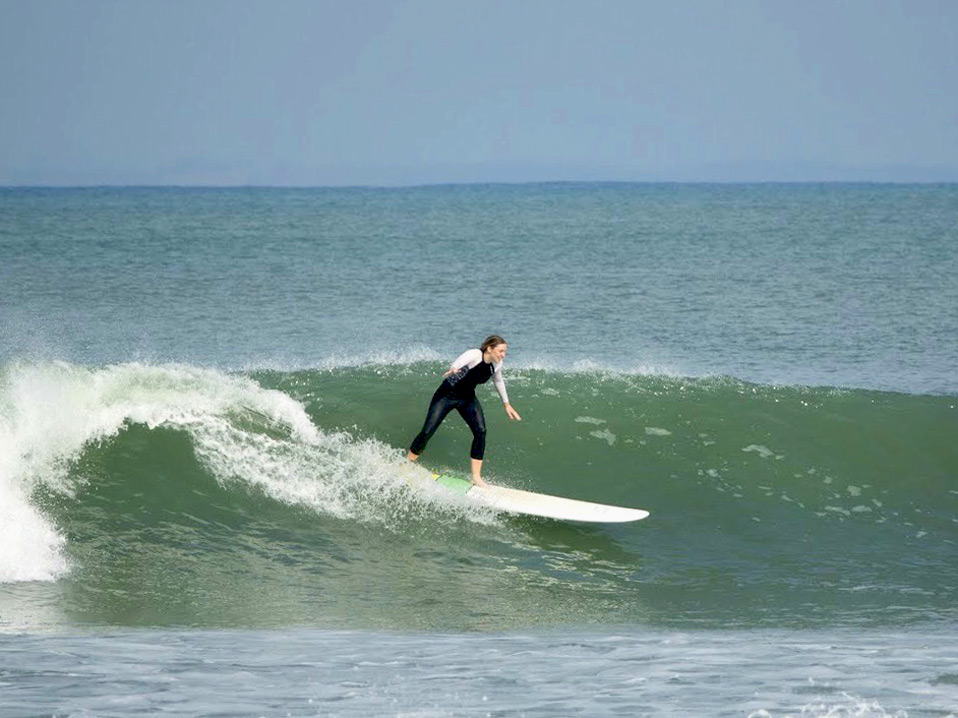
Our guest Isabelle, April 2018. We can see surf conditions generally shoulder to head-high at the same spot
(Here is the kind of waves that we get at one of our beginner surf spots during a medium swell in Costa Rica. This student had never surfed before joining the surf coaching retreat)
Long, slow and smooth waves are perfect to adjust your position on the board and practice taking a direction on an unbroken wave. Next, you can learn to generate speed to eventually start making turns up and down the face.
We think it’s the best surf spot for beginners in Costa Rica and in Central America to start surfing. Hence, the reason this location was chosen for our surf camp.
What is the longest wave in Central America?
If you’re an intermediate or advanced surfer, make sure to put Pavones on your bucket list because it’s definitely one of the best waves in Central America.
Located only a few minutes away from our surf camp, Pavones is considered to be the 2nd longest left in the world and the longest wave in Central America.
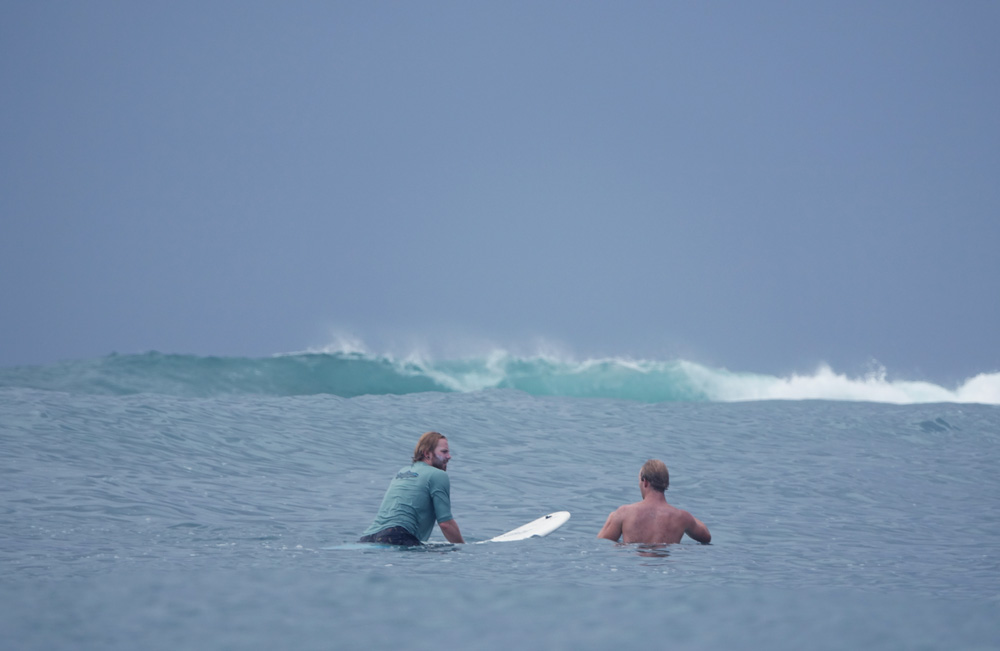
Our guest Jeff, during a personalized surf lesson in July 2019 – boat trip at the end of the week of the surf camp in Costa Rica.
How rainy is the “Rainy Season” in Central America?
“The real rainy season” (aka the most intense period of the rainy season) is the most ideal for uncrowded sessions in big surf.
Either avoid it or take full advantage of it!
It’s often during this time of the year that the best surfers travel to Central America. The waves are more powerful and there is hardly anyone in the water.
Advanced surfers usually prefer to sacrifice their tan for an intense surf session with less crowd in the water. But 3 weeks without the sun can be a bit intense and depressing for some people expecting to roast in the sun during their vacation.
We choose to not offer any surf retreats during these months of the year because the waves and the weather are not always optimal for surf lessons.
You can check our surf travel calendar to see when we offer surf coaching retreats.
Surf tips: Earplugs are essential due to the dirt and debris washed into the water by heavy rain.
We recommend 2 brands: Mack’s * earplugs (disposable and affordable – it’s a silicone that moulds to your ear) and Surf Ears “(several sizes available, expensive, but good for the pros- let the sound pass but blocks the water). We have no compensation agreement with these companies. These are just brands that we like to use.
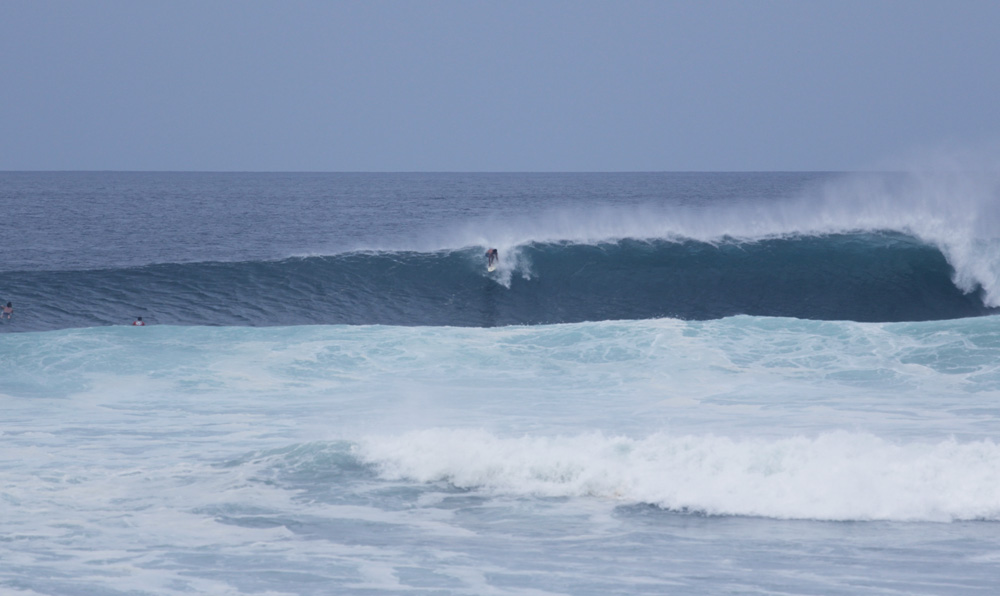
Sebastien, Surf Expedition Founder, September 2011 – Nicaragua
Surfing Central America: An Ever-Changing Adventure
Anyone who has been surfing Central America will have their own opinions on the best time to go.
Predicting weather patterns accurately due to climate change can be tricky. Moreover, it‘s become more difficult than ever to predict what mother nature is going to bring.
For instance, in the last two years, there have been big swells in February each year in the south of Costa Rica.
Normally, this swell comes only during July.
As the world is changing quickly, booking a surf trip has its uncertainties.
Despite these, one thing remains constant — surfing in Central America is always a fun time.
Consider joining one of our surf expeditions if you’re eager to enhance your surf skills and practice safely.
We hope this article was helpful for you and that you’ll have a fun time surfing in Central America,
See you in the water!

